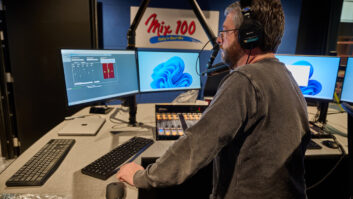Let me start off by telling a little story to which I�m sure quite a few of you can relate.
We have a mountain top RPU receiver located in the Verdugo hills (near Burbank, Calif.) that recently went silent. Naturally, we looked into it and determined that the 5 KHz telephone circuit we had been using to backhaul the audio was dead.
xNodes are normally operated in an Axia IP network, but can also be used independently. A call to telco resulted in the following response: �We�re sorry, but the equipment is obsolete; we don�t have any spares, and by the way, the techs who worked on it, and know how to make it work, are all retired now. Why don�t you put a full T1 in to replace it? We know how to make that work.�


Clearly, putting in a full T1 isn�t something we�re going to do to backhaul a single, low-bandwidth channel. After the laughing died down, though, we were still in need of a solution.
IP TO THE RESCUE
If you can�t beat them (which you can�t) then you might as well join them. Your local telco is more than happy to sell you a high-speed IP data link, as opposed to an old-fashioned wireline circuit.
Likely you�ll notice a few advantages:
The circuits can be far more economical. Sure, all you need is a T1 to the transmitter, right? But you could find, with a little research, that a circuit with 10 times the data capacity costs only twice as much. (Check your local tariffs.) Will you find a way to use that extra data? It�s very likely, yes.
Instreamer, and its complement, the exstreamer, are used to move audio in one direction only.Customer service is far better. My experience has been that the telco personnel dealing with �big� data circuits are far more responsive and adept at getting circuits back up and running. No leased circuit is infallible; but you do want fast turnaround on repairs, obviously.

Ease of use. You�ll find (especially if you have more of an IT background) that the newer data circuits are far easier, and cheaper, to make use of, than are T1 circuits (not to mention higher-speed TDM circuits, like T3).
Metro Ethernet or some other variation is an option in many cases now. Both Verizon and AT&T offer their own flavor of it. (You might find that your usual telco rep doesn�t deal with high-speed IP connectivity, so be forewarned.)
Basically, metro Ethernet provides a layer-2 connection between both ends. The amount you pay is going to depend upon your service level agreement; its variables are the overall amount of data capacity and the latency.
BRIC II pairs operate in a full-duplex mode. As an example, for my station group in Los Angeles, we pay for our studio end, with 100 mbps total capacity; for the transmitter site end, 20 mbps total capacity; and finally, our SLA guarantees less than 15 ms of latency.

While it�s common knowledge that ISDN is going away, what about other wireline circuits? Verizon has been selling �copper� assets for quite some time. �Verizon has had a long history of offloading wireline assets after its predecessor Bell Atlantic completed its multi-billion dollar merger with GTE, one of the largest non-Bell telcos, in 2000,� according to FierceTelecom (http://tinyurl.com/jls7xoz).
So what does that mean for us? I�m not saying wireline is going away in general; I�m just pointing out that the owners of the infrastructure gear used, for any type of wireline circuit, may one day change. If your telco is selling their wireline assets, they�re not likely to maintain them, or care about them that much.
The good news is that you�re not limited to using telco to provide IP connectivity. You could develop your own means of moving packets from A to B, either because you want complete control of your own data circuits, or perhaps to hedge against Telco troubles. (In other words, you could make use of a data circuit from Telco, while backing it up with your own private radio link.)
Two options are:
The DB90TX is a model of simplicity; paired with the DB90RX, it moves audio in one direction.Licensed microwave link. There are bands inside of which you can license your own very high speed data circuits. Study part 101 for the details. (Also, be on the lookout for our upcoming May issue for more information on part 101.)

ISM band radios. If you are slightly more daring, you can always make use of the unlicensed spectrum (the ISM bands) for IP connectivity between two points. (The Ubiquiti Rocket series comes to mind, although there are many others.) These can provide a great solution if you are in a time crunch, since the gear is cheap and readily available.
AOIP CODECS
After building your network transport you�ll still need a way to encode and decode the audio. Audio over IP codecs come in all different shapes, sizes and price points. All have much in common in terms of functionality (moving audio from one point to another via IP) and most of them also have full duplex capability, meaning they move audio in both directions. Each can be configured via Ethernet�either via an embedded web server, or by way of a proprietary user interface. Another common feature is analog line-level inputs and outputs, via XLR connectors; many feature AES-3 inputs/outputs as well.
Let�s take a look at some of the commonly used codecs that are on the market.
Axia xNode. xNodes are half-rack-width devices that are integral pieces of an Axia AoIP network, but you can use of them in a standalone configuration on their own network (which could be made up of a set of IP radios).
xNodes are available in analog, AES/EBU, microphone-level, mixed-signal and GPIO versions. The audio version can be configured for four stereo channels, or eight mono channels, and uses RJ45s or db 25 connectors for its audio ins and outs. They�re AES-67 compatible.
A particularly germane feature, in the context of this article, is their dual NICs: You can connect the xNode to two separate networks, using its �automatic failover� capability to send its IP traffic over a backup network in the event that the primary goes down. Configuration is done via the embedded browser.
GatesAir IP Link pairs make a full-duplex codec setBarix Instreamer/Exstreamer. Barix makes an economical set of devices used to move audio over IP in one direction only: the Instreamer and Exstreamer.

Each has a very small form factor and uses dual IHF inputs/outputs (-10 dBV level). Instreamer is the standalone IP Audio Encoder with support for MP3, PCM and G.711 (uLAw/aLaw) audio codecs, at data rates up to 320 kbps, using the IP streaming standards TCP/IP, RTP, SIP and multicast. Both it, and its complement, the Exstreamer (decoder) are configured via an embedded browser. The pair supports serial communication as well, as high as 230,400 baud.
Comrex BRIC link ll. The Comrex BRIC-Link II is another economical solution for audio over IP transport. BRIC-Link IIs occupies half-rack width; XLR connectors are used for audio input and outputs, while DIN connectors are used for contact closures, serial data, and its power supply input. (Alternately, the Left I/O connectors may be switched to AES3 digital audio format).
BRIC-Link II offers a stereo or mono linear mode that does not compress audio; for situations where reduced bandwidth is required, BRIC-Link II offers AAC/HE-AAC modes as standard, in addition to its Opus audio compression, and the VoIP standards G.722 and G.711.
Configuration is done via an embedded Web server, allowing the user to access all controls. The Web page also displays connection status, extensive network diagnostics, and audio level meters for remote monitoring.
Bridge-IT is a half-rack width, full-duplex AoIP codec.DEVA DB90-TX and DB90-RX. The DB90 TX/RX pair, like the Barix options, operate together to move audio over IP in a single direction. They are small in form-factor and use RCA connectors for analog audio inputs, but they support S/PDIF digital audio, as well.

The TX can be used as an Icecast compatible server, Icecast Source Client or Real Time Protocol sender. The DB90-RX utilizes one main and two backup audio sources; the user can choose between IP sudio, Icecast or the RTP Audio Player. The source priority is user-defined; if the audio signal of the main source disappears, the device will switch to the first available backup source and vice-verse: when the main audio signal is recovered, the RX will automatically switch back to it.
Both TX and RX are managed through a standard Web browser. iOS and Android devices are supported as well.
GatesAir IP Link. IP Link comes in two different versions: the 100, which is for a single stereo bi-directional transport; and the 200, which supports two stereo bi-directional channels. IP link is a single RU device; the 100 uses XLR connectors for audio ins and outs; digital ins and outs are via AES-3. (The 200 uses RJ45 connectors for audio i/o on its second set of channels.)
Standard coding algorithms are linear PCM, AAC-LC, Opus, and G.722. (Optional algorithms are AC-HE, AAC-HEv2, AAC-ELD, MPEG2 and 3, and EaptX. Support for AES over 192 kS/s is also an option, allowing transmission of FM composite over AES.) IP Link makes us of RTP, SHOUTcast/ICEcast and MPEG-TS protocol encapsulation.
Wheatstone Edge provides the interface between Wheatnet-IP and longer-latency IP networks. IP link features three separate Ethernet connectors, supporting three different networks; this also gives it some other capabilities that important in the current context. For example, the user can configure the decoder to switch back and forth between alternate stream sources (from different networks) as necessary.

The user can also configure FEC, programmable time diversity and interleaving of streams to combat �burst� packet losses. As an option, it features �dynamic stream splicing� which is GatesAir�s methodology for mitigating the effect of lost packets by sending duplicate streams over multiple links.
Configuration of IP link is done via its embedded Web browser.
Tieline Bridge-IT. The Bridge-IT is a 1/2 rack width, full-duplex codec with XLR connectors for audio ins and outs as well as for AES-3 digital ins and outs. Codec Algorithms include Linear PCM, Enhanced apt-X, AAC-LD, AAC-HEv1, AAC-HEv2, AAC-LD and AAC-ELD. Tieline�s �SmartStream IP� software automatically manages jitter buffering and FEC. Bridge-IT also features 2 relay inputs, 2 relay outputs, and RS-232 for remote control applications. It has the full complement of front panel controls for configuration, via an LCD display, PPM metering and a key pad. Naturally the user can also configure it via its embedded Web browser.
APT Silver encoder/decoder pairs are used to move audio in one direction only.Worldcast (APT) Encoder Silver and Decoder Silver. The Silver encoder/decoder pair represents another economical means of audio transport via IP. The form-factor is � rack width, with balanced audio inputs and outputs via XLR connectors. Standard coding algorithms include linear PCM, Enhanced apt-X, MPEG 2 and 4 (HE-AAC versions 1 and 2). Serial data transport, up to 115,200 baud supported via db9 connectors, as is auxiliary data (which is bi-directional, done via UDP). The Silvers are N/ACIP compliant, and also supports Dynamic DNS (which is important if one end of your link doesn�t have a static IP address. See our February 2016 edition for more on the topic.) The Silvers are configured via their embedded web servers.

The IP Silver has a single Ethernet port, but still comes standard with Worldcast�s SureStream. In this case, two streams would be configured, and the time delay between the two is used to mitigate the effect of lost packets.
Wheatstone NetworkEdge. The Network EDGE blade was designed specifically as an interface between AoIP studio networks (i.e., WheatNet-IP) and longer-latency IP networks. Typically located at the studio, the Network EDGE interfaces directly (via Ethernet) to an IP wireless radio or commercial leased line to provide point-to-point connectivity between locations. Network EDGE can be used with any of the major IP radio brands currently on the market, according to Wheatstone.
The Network EDGE is a single RU device that includes local I/O (two AES and two stereo analog) and 12 programmable logic ports.
This list is not meant to be exhaustive; I�ve only mentioned one product per manufacturer, as you can see, to give you some idea of what is available. I strongly recommend that you take a look at the other devices offered by these same companies.
The ubiquitous nature of IP gives the radio engineer many options of ways to connect point A with point B, whether for STLs, for remote broadcasts, for talent that wants to work from home, and the myriad of other reasons neither I nor you have thought of yet.
If one of your legacy methods is the use of telco audio circuits, you should plan for the day they disappear. It could be closer than you think.










